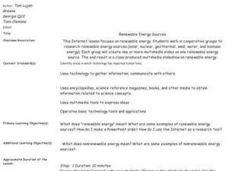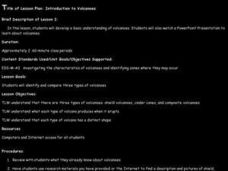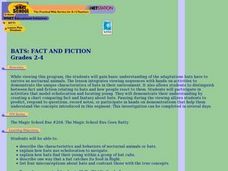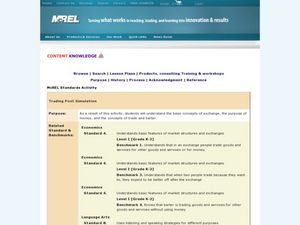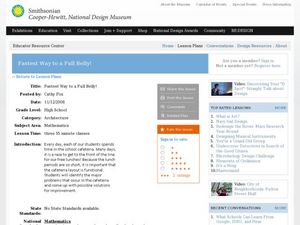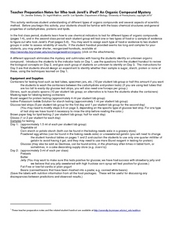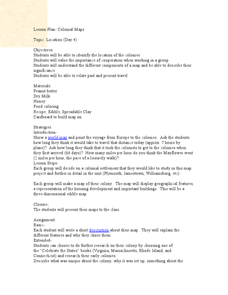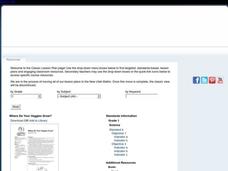Curated OER
Environment: Renewable Energy Sources
Learners, in groups, conduct Internet research on various renewable energy sources. The groups create several multimedia slides for inclusion in a class presentation. Topics covered include solar, nuclear, and geothermal power.
Curated OER
Leadership and Proactive Problem solving: Discussion Scenarios For International Travel and Development Work
Students take an international trip to explore global issues and problems. In preparation for the trip, groups of students participate in a role play of situations they may face overseas. They discuss the outcome and problem solving...
Curated OER
57 Varieties of Interdependence
Learners examine the life of Henry J. Heinz and how he began his career in food service. For this economic history lesson,students study how Henry J. Heinz started his business. Learners will create and answer key...
Curated OER
Exploring Limu Diversity
Young scholars explore limu diversity. In this ocean ecosystem lesson, students classify limu according to its physical properties. Young scholars work in small groups to generate scientific observations and sort limu by characteristics.
Curated OER
Introduction to Volcanoes
Students develop a basic understanding of volcanoes. They watch a PowerPoint Presentation which introduces three types of volcanoes: shield volcanoes, cinder cones, and composite volcanoes.
Curated OER
Treaties
Third graders explore Canadian history by participating in a role-playing activity. In this First Nation treaties lesson, 3rd graders identify the difficulties the Aboriginals faced when dealing with early European settlers. Students...
Curated OER
Bats: Fact and Fiction
Learners describe the characteristics and behaviors of bats. After viewing a video, they explain how bats use echolocation to navigate and how they find their young within a group. They list four misconceptions about the animal and...
Curated OER
Trading Post Simulation
Students explore the concept of trade. In this trade lesson, students simulate a trade store. Students are divided into two groups. Half the class runs the store, half the class are customers. Students try to trade goods and services in...
Curated OER
How Can We Keep Our Forests Intact and Have Our Chocolate Too?
Fourth graders explore various methods of growing and harvesting rainforest foods in order to sustain its biodiversity. They discuss the various uses for trees from several viewpoints. Students research chocolate demand and land use...
Curated OER
Viruses, Bacteria, Protists, and Fungi
In this viruses, bacteria, protists, and fungi instructional activity, students will review the basic characteristics of each of these groups. Students will complete 7 fill in the blank questions about viruses, 6 true or false questions...
Curated OER
The Business of Design
Students visit the Design for the Other 90% exhibition. In this design lesson plan, student learn how to design for the population of the world that is poor or impoverished. In addition, students read New York Times articles and watch...
Curated OER
Fastest Way to a Full Belly
High schoolers create a scale model of a cafeteria. In this scale lesson, groups improve their actual school cafeteria layout by taking measurements of the structure and redesigning furniture and food serving lines. They create a scale...
Curated OER
Who Took Jerell's iPod?
Young scholars investigate various substances to determine the perpetrator of a crime. In this biology lesson, students test for the presence of organic compounds in various samples. They identify an unknown substance based on its...
Curated OER
Edible Plant Parts
Students participate in various activities to discover the six basic types of plants. In groups, they analzye the foods they eat and identify which part they consume. After reading "The Fablous Food Phantom", they create a food phantom...
Curated OER
Colonial Maps
Students discover the history of America by identifying the traditional colonies. In this U.S. history lesson, students examine a world map and identify where the voyagers left from Europe to arrive at the United States. ...
Curated OER
Where Do Your Veggies Grow?
First graders investigate the origins of vegetables. In this Science lesson, 1st graders identify where fruits and vegetables come from. Students describe how people utilize plants.
Curated OER
Eating for Your Future
Students brainstorm ways to live healthy. For this health science lesson, students recipes that are healthy and appealing. They compile all recipes and develop a class cookbook.
Curated OER
Knowing your nutrients
Learners comprehend the basics of the nutrition label. They comprehend the Recommended Daily Allowances. Students analyze the regulations that govern food labeling. They review the Food Pyramid.
Curated OER
Microwave Introduction
Sixth graders learn the principles of microwave cooking and how to use and care for it properly while preparing foods.
Curated OER
Design-A-Meal
Third graders record what they eat for a week. In groups, they develop a menu for a fictitious restaurant. They create dinners which include all groups from the food pyramid. To end the lesson, they practice making healthy food...
Curated OER
Family Life Cycle - Breakfast Lab
Learners review the nutritional needs of various age groups. In groups, they plan a breakfast meal for different age groups and spend time making the foods. To end the activity, they serve the food to their classmates for an evaluation.
Curated OER
Staying Healthy Year Round
Students are read a variety of books and observe the weather in the different seasons. In groups, they compare and contrast the type of activities people are doing. They also discuss how they adapt to the changes in seasons by the...
Curated OER
House Bill No. 4097
Learners identify healthy and unhealthy foods while considering a bill that would ban certain foods in schools. Through survey and discussion, they discuss a proposed legislative bill that would ban certain types of food in schools....
Curated OER
The Needs of Living Things
Students watch video clips of animals and plants in their natural environment, to gather evidence that all living things have basic survival needs. Students draw pictures of real or imaginary pets eating, drinking, breathing, and taking...
Other popular searches
- Five Basic Food Groups
- Four Basic Food Groups
- 4 Basic Food Groups
- 5 Basic Food Groups
- Basic Food Groups Free
- 3 Basic Food Groups
- Basic Food Groups Worksheets
